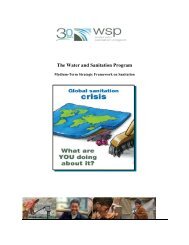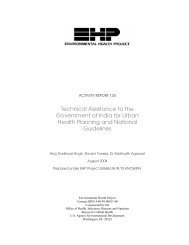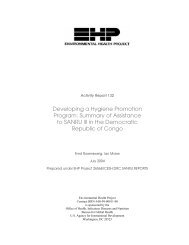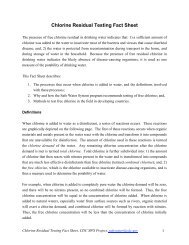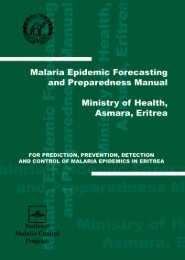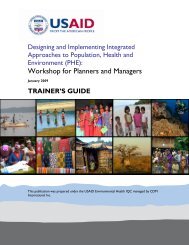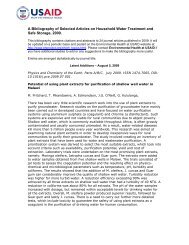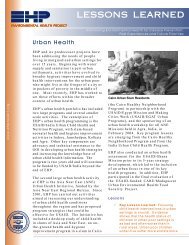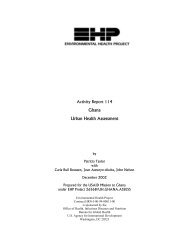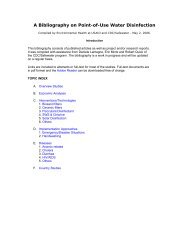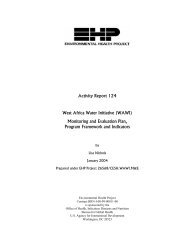Changing Glaciers and Hydrology in Asia - Environmental Health at ...
Changing Glaciers and Hydrology in Asia - Environmental Health at ...
Changing Glaciers and Hydrology in Asia - Environmental Health at ...
- No tags were found...
You also want an ePaper? Increase the reach of your titles
YUMPU automatically turns print PDFs into web optimized ePapers that Google loves.
Previous assessments of the glacier melt impact on surface w<strong>at</strong>er supply have been primarilyeither highly qualit<strong>at</strong>ive or local <strong>in</strong> scale, or, <strong>in</strong> some cases, simply <strong>in</strong>correct. For example, valuesreported <strong>in</strong> S<strong>in</strong>gh <strong>and</strong> Bengtsson (2004) <strong>and</strong> Barnett et al. (2005) appear to be far too large.Barnett et al. (2005) st<strong>at</strong>ed th<strong>at</strong> “There is little doubt th<strong>at</strong> melt<strong>in</strong>g glaciers provide a key sourceof w<strong>at</strong>er for the Himalayan region <strong>in</strong> the summer months: as much as 70% of the summer flow<strong>in</strong> the Ganges <strong>and</strong> 50–60% of the flow <strong>in</strong> other major rivers.” Little evidence supports such highvalues for the contribution of glacier ice melt to total river flow volume.Rees <strong>and</strong> Coll<strong>in</strong>s (2006) believe th<strong>at</strong> if all glaciers were to disappear, there would be a muchgre<strong>at</strong>er impact on the w<strong>at</strong>er resources of the west than the east, with reduction <strong>in</strong> annual meanflow of about 33% <strong>in</strong> the west, but only about 4–18% <strong>in</strong> the east, compared to 1990 levels,because of the clim<strong>at</strong>ic differences between the drier western <strong>and</strong> monsoonal eastern ends ofthe region. They note th<strong>at</strong> high discharge from glacier ice melt often dom<strong>in</strong><strong>at</strong>es flow forconsiderable distances downstream, particularly where other sources of runoff are limited. Theyalso specul<strong>at</strong>e th<strong>at</strong>, should Himalayan glaciers cont<strong>in</strong>ue to retre<strong>at</strong> rapidly, w<strong>at</strong>er shortages mightbe widespread with<strong>in</strong> a few decades.A study by Alford et al. (2010) <strong>in</strong>dic<strong>at</strong>es th<strong>at</strong> <strong>in</strong> Nepal the glacier contribution to sub-bas<strong>in</strong>stream flow varies from approxim<strong>at</strong>ely 20% <strong>in</strong> the Budhi G<strong>and</strong>aki Bas<strong>in</strong> to approxim<strong>at</strong>ely 2% <strong>in</strong>the Likhu Khola Bas<strong>in</strong>, averag<strong>in</strong>g approxim<strong>at</strong>ely 10% across n<strong>in</strong>e bas<strong>in</strong>s. This discharge volumerepresents approxim<strong>at</strong>ely 4% of the total mean annual estim<strong>at</strong>ed volume of 200,000 millioncubic meters for the rivers flow<strong>in</strong>g out of Nepal. Under current clim<strong>at</strong>e conditions, results<strong>in</strong>dic<strong>at</strong>ed th<strong>at</strong> the glaciers of Nepal experience no significant melt over approxim<strong>at</strong>ely 50% oftheir surface area <strong>at</strong> any time of the year. This is <strong>in</strong> sharp contrast to lower elev<strong>at</strong>ion glaciers ofthe world th<strong>at</strong> melt over their entire surface dur<strong>in</strong>g the summer months, often result<strong>in</strong>g <strong>in</strong>significant mass loss.For the upper Indus Bas<strong>in</strong>, Immerzeel et al. (2009) found th<strong>at</strong> glacier melt contributedsubstantially to streamflow – 32% <strong>in</strong> a reference situ<strong>at</strong>ion, peak<strong>in</strong>g <strong>in</strong> July (with snow meltprovid<strong>in</strong>g 40% of the total with a peak <strong>in</strong> June, <strong>and</strong> ra<strong>in</strong> compris<strong>in</strong>g 28% with a peak <strong>in</strong> July). Theremoval of all glaciers, with an accompany<strong>in</strong>g <strong>in</strong>crease <strong>in</strong> the w<strong>in</strong>ter <strong>and</strong> summer temper<strong>at</strong>uresof 4.8 o C <strong>and</strong> 4.5 o C respectively <strong>and</strong> precipit<strong>at</strong>ion <strong>in</strong>creases of 19.7% <strong>and</strong> 15.7% (clim<strong>at</strong>e modelscenario for 2071-2100) <strong>in</strong>dic<strong>at</strong>ed summer maximum flow reduction of approxim<strong>at</strong>ely 30% <strong>and</strong>reduction of total precipit<strong>at</strong>ion fall<strong>in</strong>g as snow from 60% to 48%. In these types of projectionsthere is typically an <strong>in</strong>crease <strong>in</strong> total precipit<strong>at</strong>ion, summer <strong>and</strong> w<strong>in</strong>ter, with melt from snowcover rema<strong>in</strong><strong>in</strong>g about the same <strong>and</strong> peak discharge appear<strong>in</strong>g approxim<strong>at</strong>ely one month earlierthan present conditions. P<strong>at</strong>terns of <strong>in</strong>creased total precipit<strong>at</strong>ion <strong>and</strong> earlier snow melt canactually be beneficial for agriculture, as this p<strong>at</strong>tern would provide more w<strong>at</strong>er for localirrig<strong>at</strong>ion <strong>and</strong> <strong>in</strong>creased <strong>in</strong>put to reservoirs when they are most empty <strong>at</strong> the beg<strong>in</strong>n<strong>in</strong>g of thegrow<strong>in</strong>g season.Immerzeel et al. (2010) have recently applied their model<strong>in</strong>g approach across the gre<strong>at</strong>erHimalayan region <strong>and</strong> conclude th<strong>at</strong> glacier melt w<strong>at</strong>er is extremely important <strong>in</strong> the Indus Bas<strong>in</strong><strong>and</strong> reasonably important for the Brahmaputra, but only plays a modest role for the Ganges,Yangtze, <strong>and</strong> Yellow rivers. Prelim<strong>in</strong>ary results <strong>in</strong>dic<strong>at</strong>e th<strong>at</strong> the snow <strong>and</strong> glacier melt24



